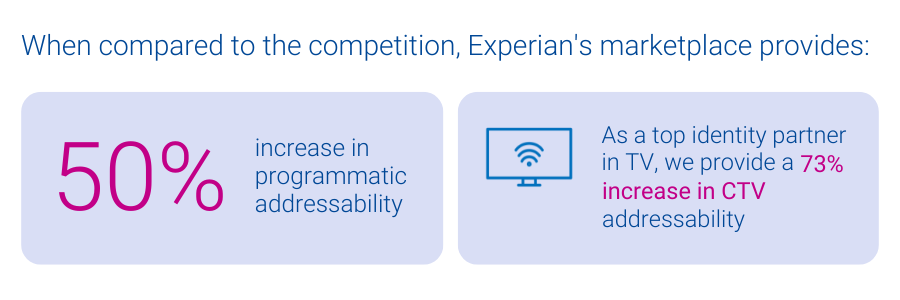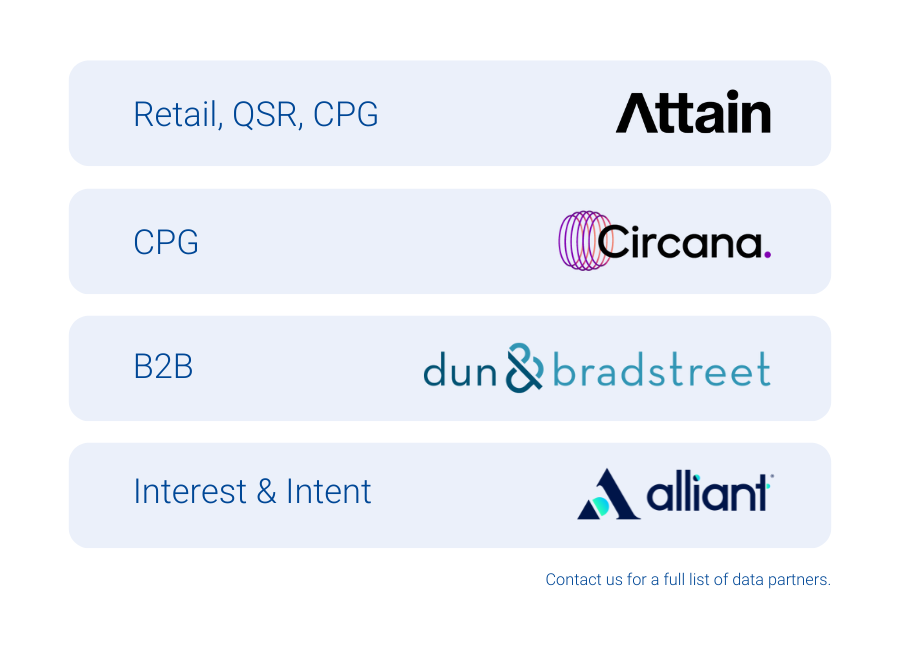
Following the success of our recent launch of Third-Party Onboarding, we are excited to introduce the Experian marketplace, a new addition to our portfolio of data-driven activation solutions.
Experian’s marketplace bridges TV operators, programmers, supply partners, and demand platforms with top-tier third-party audiences across retail, CPG, health, B2B, and location intelligence. Easily activate premium audiences from leaders like Attain, Alliant, Circana, and Dun & Bradstreet – driving precise, efficient consumer reach.
“Experian has been a longstanding partner of DISH Media, and we’re excited to be an early adopter of their marketplace which leverages the foundation of their identity solutions to ensure maximum cross-channel reach as we look to expand the breadth and depth of data we use for addressable TV.”
Kemal Bokhari, Head of Data, Measurement & Analytics, DISH Media
As privacy regulations evolve and traditional identity signals shift, many activation platforms face declining addressability. This impacts their ability to effectively reach consumers, which is critical to staying competitive. Experian’s marketplace, powered by our identity graphs which include 126 million households, 250 million individuals, and 4 billion active digital IDs, enables audiences to be easily activated and maintain high addressability across display, mobile, and connected TV (CTV) channels.


Benefits of Experian’s marketplace
- Enhanced addressability and match rates: All audiences delivered from our marketplace benefit from our best-in-class offline and digital identity graphs, which ensure addressability across all channels like display, mobile, and CTV. Unlike other data marketplaces, Experian ensures all identifiers associated with an audience have been active and are targetable, improving the accuracy of audience planning.
- Simplified audience planning and distribution for TV Operators: TV operators can build custom audiences matched directly to their subscriber footprint and distribute them across all advanced TV channels (data-driven linear, addressable, digital, and CTV) for maximum impact.
- Diversification within the data marketplace ecosystem: With the recent departure of Oracle’s advertising business, the optionality for buyers and sellers to connect with third-party data has become increasingly limited. With Experian marketplace, we’re excited to offer a new solution to the market that ensures data-driven targeting can continue to take place at scale.
- Lower activation costs: Experian’s marketplace offers transparent, pass-through pricing with no additional access fees, enabling partners to maximize their earnings while reducing costs.
- Audience diversity and scale: Platforms can access a broad range of audiences across top verticals from our partner audiences, which can be combined with 2,400+ Experian Audiences. This offers the flexibility, reach, and scale necessary to effectively execute advertising campaigns.
- Remove compliance concerns: Experian’s rigorous data partner review ensures available audiences comply to all federal, state and local consumer privacy regulations.
“Circana and Experian have enjoyed a deep partnership for over a decade. We are exceedingly excited to extend our partnership and be an early adopter and launch partner of the Experian data marketplace. This additional capability will enable the ecosystem to more easily access Circana’s purchase-based CPG and General Merchandise (for example Consumer Electronics, Toys, Beauty, Apparel etc.) audience segments to drive performance outcomes across all media channels.”
Patty Altman, President, Global Solutions, Circana

“Capturing the attention of target audiences across channels is critical for marketers navigating an increasingly connected digital world. We are excited to be an exclusive provider of B2B solutions within Experian’s marketplace, helping brands and media agencies to accelerate their reach, addressability and targeting capabilities across TV, mobile and connected TV channels.”
Georgina Bankier, VP of Platform Partnerships at Dun & Bradstreet
Better connections start here: Experian’s marketplace
Experian’s marketplace, easily accessible from our Audience Engine platform, brings unparalleled addressability, enabling our clients to reach more relevant consumers and increase revenue.
If you’re interested in learning more about Experian’s marketplace or becoming an active buyer or seller in our marketplace, please contact us.
Latest posts

The annual back-to-school season is in high gear and Moms are preparing lists and sizing up their children’s clothing and school-related merchandise needs. It’s an important time of year for retailers, as apparel, shoes, electronics, furniture, computers, backpacks and school supplies will account for the bulk of consumer spending during the back-to-school shopping season. Many marketers have historically grouped the back-to-school audience into one collective segment of households with school-age children. This leaves money on the table because there are better ways to target Moms with kids when developing a back-to-school promotional strategy. Just like the inventory of new clothes and notebooks that retailers have neatly arranged on store shelves, families with school-age children come in an assortment of sizes, shapes and colors. What is the most effective way to segment the back to school audience? This begs the question “” Marketers can always turn to basic data elements for segmentation. These include age and gender of children, number of children in the household, parent’s age, household income, and the full spectrum of school classifications (preschool, elementary school, middle school, junior high school, high school, etc.). Though a more powerful approach would be to utilize a segmentation methodology that recognizes the lifestyle and behavioral differences among households that are most likely to contain school-age kids. Here are three snapshots of family-oriented, children-centric market segments that are highly likely to be responsive to a wide variety of back to school promotional offers. All three segments have been selected from Experian’s Mosaic lifestyle segmentation solution. Babies and Bliss Description: Babies and Bliss represent the premier lifestyle for large families in America. With a majority of households containing at least five people, this segment is a haven for large broods living in new suburban subdivisions. Parents in this segment tend to be in their 30s and 40s. There is a wide range of kids in these households, from preschoolers up to those in high school. There is also money in this segment, reflecting the high educations and low six-figure incomes that come from dual earners employed in professional and technical occupations. Some key traits of Babies and Bliss households include upscale tastes, large families, well-educated, conservative views, financially-savvy, convenience, and power shopping. Implications: Given their large families, it's not surprising that Moms from Babies and Bliss households are value-conscious shoppers who seek appealing deals for quality merchandise. They carry coupons, like to comparison shop when buying expensive items and head to the clearance rack first whenever they buy clothes, which tend to be conservative in style. In the mall, these Moms follow their children's lead but also remain very open to consider generic store brands rather than high-priced name brands. They like to shop (it's practically a sport) and are happy to open their wallets at department stores, specialty shops, catalogs and online sites. They especially pride themselves in being very Internet-literate. With their jobs, kids and errands, they appreciate the convenience of shopping online and are receptive to email ads, sponsored Websites and Web page links. Families Matter Most Description: A fast-growing segment, Families Matter Most consists of young, middle-class families in suburban locations leading active, family-focused lives. Nine out of ten households have kids (nearly two-thirds have multiple kids). These young, middle-class families have settled into a landscape of recently built subdivisions. Many adult household members are urban exiles who've sought a suburban setting with room for kids to grow. They are proud of their new homes, schools and shopping centers, where they can find everything they need just a short drive away. Families Matter Most distinguish themselves by having adopted attitudes and routines to help them effectively juggle the responsibilities of work and child-rearing. Some key traits of Families Matter Most households include sprawling families, family values, casual perspectives, price-sensitivity, credit revolvers, conformists and risk avoidance. Implications: Families Matter Most are casual in their attitude except when it comes to their children. They take their role as parents very seriously, which they describe in conservative terms. They avoid risks and feel little need to make a statement with their possessions. As shoppers, Moms from Families Matter Most households are price-sensitive consumers who look for discount stores that offer durable and comfortable fashion. They are worried about spending money impulsively and try to be informed consumers. Most are happy to wear last year's fashions and they tend to zero in on a few stores that carry the affordable brands they prefer. With their growing families they shop most often at discount and mid-market national chains including Target, Walmart, Kohl's, Toys R Us and Old Navy. Cul de Sac Diversity Description: Cul de Sac Diversity consists of ethnically diverse, middle-aged couples with school-aged children. This segment has an above-average concentration of Hispanic and Asian household members. Nearly one-third of Cul de Sac Diversity adult members are foreign-born. They are three times more likely to be bilingual compared to U.S. adults overall. These upper-middle-class households are well on their way to achieving the American dream. They believe in home and family, but also recognize the need to work to get ahead. They look at their work as a career, not a paycheck, and are willing to give up family time in exchange for the opportunity to advance in their careers. Some key traits of Cul de Sac Diversity households include ethnically diverse, bilingual, mainstream mindset, community-minded, tolerant and career-focused. Implications: Moms from Cul de Sac Diversity households like to shop with friends and family members in order to get everyone's opinions on potential purchases. As consumers, they often seek status and recognition through their possessions. They are attracted to designer labels and sometimes spend more on clothes than they can truly afford. They like going to mainstream retailers to shop for their children including Kohl's and Macy's as well as sporting goods chains such as Dick's Sporting Goods and Sports Authority. They are only moderately receptive to online advertising. Deploying a back to school marketing strategy that treats all households with school-age children as one undifferentiated market is like creating a basic lesson plan and applying it to all grade levels of a one-room schoolhouse. Instead, marketers are encouraged to study their target audience more closely. With key insights in hand, they will have acquired the necessary prerequisites for graduating to a strategy that acknowledges the shopping characteristics and needs of a diverse and potentially lucrative audience of back-to-school Moms and their children.

Segmentation Layering For many marketers, segmentation is like breathing – it comes naturally and is a part of everything they do. To better connect with your target audience, use a good segmentation system with multiple layers that provides a breakdown of essential information while tying in lifestyle and transactional data. Consider marketing to parents. The most basic information includes demographics such as age, income, presence of children, etc. Add to that lifestyle information – the family has two working parents who rely heavily on the Internet for research and purchase convenience. The transactional data can really set apart where a parent falls on the parenting lifecycle. For example, is the parent still purchasing diapers and feeding supplies for their infant or bedding, towels and a coffee maker that might indicate their “baby” is headed to college? Both parents may look similar when comparing demographic and lifestyle information but the transactional data differentiates their needs. According to Experian Marketing Services: Parents use the Internet far more than the average American Moms are 34% more likely to buy products online and 33% more likely to participate in a blog than the average adult. "Marketers are targeting more carefully based on both the parents' life stage and consumer behavior,” says Jan Jindra, senior product market manager at Experian Marketing Services. “Younger parents, and those of smaller children, have different information needs than parents of older or college-age children. It's not only the life stage they're in, but the lifestyle," Jindra says. Read the full article and check out the latest in marketing to parents in DMNews: http://www.dmnews.com/household-brands-observe-parents-needs-in-defining-segmentation-tactics/article/205902/.

Retailers are realizing that a large percentage of their revenue stream comes from existing customers, which is why so many starting to invest in customer loyalty programs. A recent Experian QAS study revealed that 63 percent of organizations track the lifetime value of each customer, and 72 percent see that value increasing over time. Loyalty programs are an effort to promote up-sell and cross-sell opportunities to make sure customers continue to buy throughout their lifecycle. However, simply investing in a loyalty program isn’t enough; retailers need to be sure that the contact data in those programs is accurate. At the most basic level, marketing offers can only reach customers when the contact information is accurate, but contact data also affects a retailer’s ability to analyze their current customer base to allow better segmentation and intelligence. To ensure data accuracy, make sure to put verification tools in place at each point of capture so that contact data is valid and complete as it is being entered. Then make sure you are updating data on a consistent basis and that it is being put into one centralized database for better analysis. Learn more about the author, Erin Haselkorn